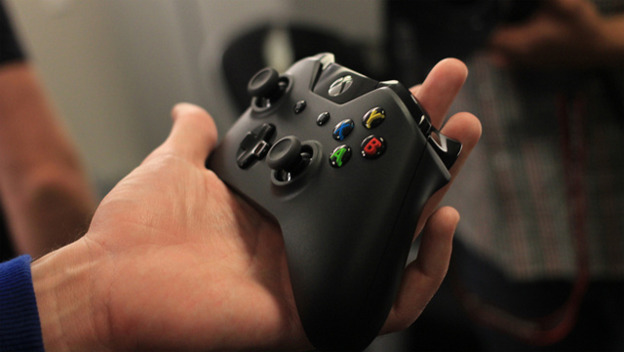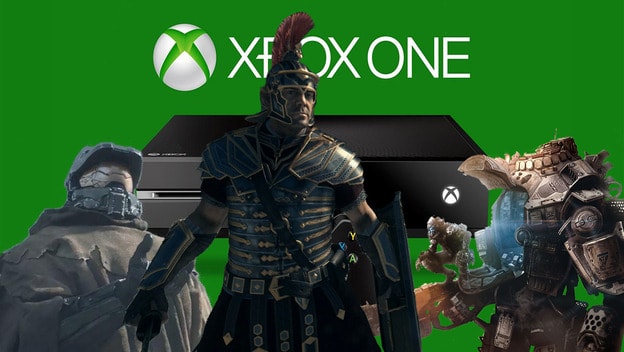The Xbox One is coming. If it wasn’t obvious from the lime green ads lining every inch of Toronto’s major subway stations, the fact was confirmed by another sign of the holiday season: the appearance of pop-up Xbox demo stores in the downtown area. Sure as the Santa Claus parade, huddled masses of chilly game writers and TV news crews were recently ushered into one such store for an Xbox One preview event.
Shiny new Ones lined every wall, running demo games and video loops; though unfortunately, certain choice games such as Dead Rising 3 and Ryse were unavailable to test during the event. Our hosts wisely kept the speeches to a minimum, simply reminding us that the Xbox One is an “all-in-one media device” and otherwise letting the consoles speak for themselves.
I chose to play Crimson Dragon , a rail shooter by Panzer Dragoon’s creator Yukio Futatsugi, to test out the conventional Xbox One controls. The new controller is similar to the Xbox 360 controller in design, but feels better constructed. The analog sticks are more sensitive and responsive. The triggers, which were used as the attack buttons in the game, have a nice crisp feel to them that is an improvement on the mushy triggers on the 360 pad.
My only complaint about the new controller is that the form factor have been changed just enough that it’s less comfortable for people with tiny mutant hands like myself. The grips have been angled out, making the analog sticks more difficult for me to reach, and I had to stretch in order to operate the triggers and bumpers while using the sticks at the same time. People with normal or large hands shouldn’t have an issue with it, and it’s still a far cry from The Duke in terms of working against the small-handed.
Crimson Dragon itself was a fun experience, though I was warned that the demo I was playing had been tweaked to be easier than the final game. It’s basically a rail shooter in which the player’s weapon is a dragon, but it boasts RPG elements such as a selection of customizable dragons and elemental breath weapons. It’s set in a world that is experiencing an alien viral outbreak, so the player and his/her partner dragon are facing off against all sorts of angry mutated scaly beasts.
My dragon (a real beast that took very little damage from my occasional crashes into falling rocks and lava streams) came loaded with a primary, cannon-style attack that was powerful but required precise aiming and a secondary attack that sent out less powerful laser zaps over a large area. As one might guess, the secondary weapon was highly effective in taking out small swarms of floating virus-beasts, while the cannon was best against the other dragons I was fighting. The two selected attacks were executed by pulling the left and right triggers, and the dragon could dodge-roll in the air by pressing the left and right bumpers. I’m not a fan of trigger-based combat systems and would probably have preferred to use the face buttons for attacking, but the pairing of the triggers and bumpers for attacking and dodging was admittedly useful.
As a game that was originally in development for the 360, Crimson Dragon’s graphics didn’t exactly show off the Xbox One’s visual capabilities, but it had a smooth framerate and nice-looking enemies. I was told that the game will also feature a multiplayer mode and a free flight combat mode that is completely off-rails. With strong action, a good dose of challenge, and a lot of depth, it looks like a great choice for console early adopters.
Stepping away from the world of controllers, I ventured over to the Kinect Sports Rivals area. Rivals won’t be fully available until next spring, but Xbox One owners will be able to download the Wake Racing game at launch. Stepping in front of the game, it was immediately apparent that it is offering something quite different from the Kinect Sports games on the 360.
For one thing, the new Kinect took very little time to register and scan me. For another, the Mii-style cartoon graphics from the past generation were gone, replaced by slick, stylish environmental graphics and realistically proportioned jet ski racers. The entire setup pointed towards the game being aimed at a core gaming audience.
That gaming focus was supported by the new Kinect’s greatly improved ability to read body motions. Gone are the days of flailing wildly in front of the sensor, hoping it would pick up the intended motion. Instead, I had to steer my imaginary jet ski with skill and subtlety. Making broad motions quickly steered me off-course into cliff walls or towards the various obstacles that had been scattered throughout the racecourse, while subtle motions were easily picked up by the sensor and kept me on course.
The Wake Racing course was a far cry from the happy rafting canyon from the original Kinect Sports as well. The jet ski reacts properly to the choppy waves of the ocean, forcing the player to adjust. There are also mines scattered about, and hitting one awards the player with an explosion and a time penalty. One particularly challenging area combines the waves with a minefield, providing lots of nail-biting action as the player attempts to steer around the mines while being knocked about by the water.

I was quite pleased to come in last place in the race, because I knew exactly why I hadn’t been good enough to compete. I needed to improve my steering skills and learn the course in order to get a good time, and I felt that the system was precise enough that my loss was down to skill rather than luck. That’s a positive thing for both core gamers and the more casual audience. Non-gamers aren’t drooling idiots who can’t handle a challenge, as some game companies seem to have assumed in the first motion-sensing generation. A strong motion-sensing system simply offers better longevity and greater competitive possibilities for everybody who plays the games.
I didn’t go into this event expecting to be wowed by the new Kinect, but I was honestly impressed by how much it has improved. Rare appears to be taking advantage of the possibilities it provides, and if other companies are willing to do so as well, Kinect could become a true core feature of gaming on the Xbox One.
The one major gaming-related aspect of the Xbox One that I wasn’t able to experience fully was the console’s interface. The promotional material Microsoft provided us discussed how the console’s home screen is personalized to the current user (as identified via login or Kinect), but not whether the user could actively personalize the interface or if it’s all done automatically. The ability to multitask is a new and welcome addition to the world of Xbox, as is the complete disappearance of the blinding lime green color scheme. Sadly, we won’t have a chance to see how much of the interface is cluttered with ads (and how much control the user has over the content of said ads) until the console launches and its network goes fully live.
Will the Xbox One convince jaded gamers to forget Microsoft’s PR disasters of the summer of 2013 and fully embrace the console? In my experience, it was a solid console with an improved controller and a greatly improved Kinect unit. Much of the rest boils down to software libraries—and the Xbox One now has a stronger launch lineup than the PlayStation 4—and whether Microsoft’s online infrastructure is truly ready for launch. The console has good potential, and it’s up to Microsoft to ensure that developers use that potential and maintain the trust of gamers by avoiding anti-consumer policies throughout the life of the console.
